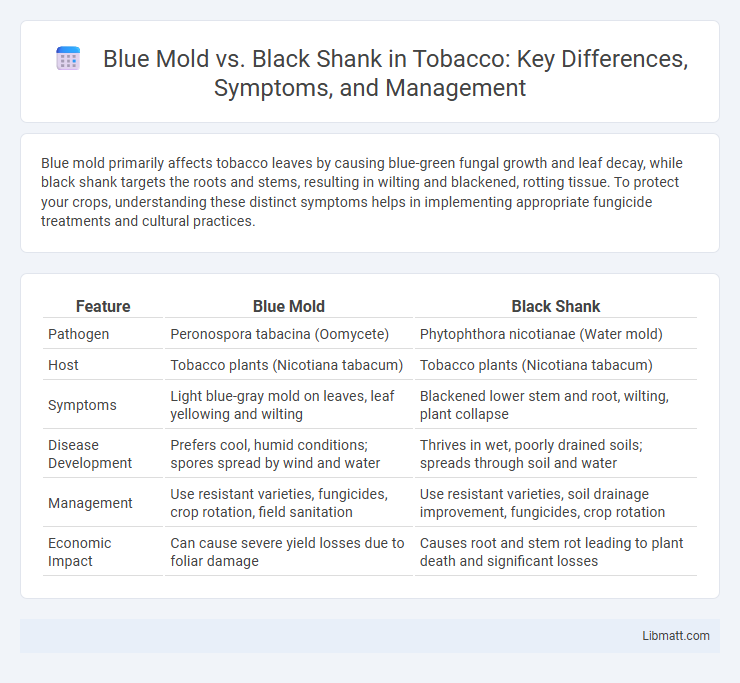Blue mold primarily affects tobacco leaves by causing blue-green fungal growth and leaf decay, while black shank targets the roots and stems, resulting in wilting and blackened, rotting tissue. To protect your crops, understanding these distinct symptoms helps in implementing appropriate fungicide treatments and cultural practices.
Table of Comparison
| Feature | Blue Mold | Black Shank |
|---|---|---|
| Pathogen | Peronospora tabacina (Oomycete) | Phytophthora nicotianae (Water mold) |
| Host | Tobacco plants (Nicotiana tabacum) | Tobacco plants (Nicotiana tabacum) |
| Symptoms | Light blue-gray mold on leaves, leaf yellowing and wilting | Blackened lower stem and root, wilting, plant collapse |
| Disease Development | Prefers cool, humid conditions; spores spread by wind and water | Thrives in wet, poorly drained soils; spreads through soil and water |
| Management | Use resistant varieties, fungicides, crop rotation, field sanitation | Use resistant varieties, soil drainage improvement, fungicides, crop rotation |
| Economic Impact | Can cause severe yield losses due to foliar damage | Causes root and stem rot leading to plant death and significant losses |
Introduction to Blue Mold and Black Shank
Blue mold and black shank are two destructive diseases affecting tobacco crops worldwide, caused by the pathogens Peronospora tabacina and Phytophthora nicotianae, respectively. Blue mold primarily targets tobacco leaves, producing blue-gray spores that lead to rapid leaf necrosis, while black shank attacks the plant's root and stem base, causing wilting and stem rot. Understanding the distinct symptoms and lifecycle of these pathogens is crucial for effective disease management and minimizing crop losses.
Pathogen Overview: Causal Agents
Blue mold is caused by the fungus Peronospora tabacina, which primarily infects tobacco plants, producing blue-gray, powdery spore masses on the undersides of leaves. Black shank is caused by Phytophthora nicotianae, a soil-borne oomycete responsible for root and stem rot in tobacco, leading to blackened, shrunken stalks. Understanding the distinct pathogens helps Your integrated disease management strategies target the right causal agents effectively.
Symptoms and Disease Identification
Blue mold presents as fuzzy, blue-green growth primarily on tobacco leaves and stems, often accompanied by leaf yellowing and wilting. Black shank causes dark, water-soaked lesions at the base of the tobacco plant's stem, leading to girdling, plant collapse, and root rot. Identifying blue mold relies on visible spore structures on leaves, whereas black shank is diagnosed by blackened stem tissue near the soil line and characteristic root decay.
Environmental Conditions Favoring Each Disease
Blue mold thrives in cool, moist environments with temperatures ranging from 55degF to 70degF and high humidity levels that promote spore germination and spread. Black shank favors warm, wet conditions, particularly soil temperatures between 75degF and 90degF, along with poorly drained soils that facilitate the growth of the Phytophthora nicotianae pathogen. Understanding these specific environmental triggers helps in implementing targeted disease management strategies in tobacco cultivation.
Geographic Distribution and Prevalence
Blue mold primarily affects tobacco crops in temperate regions of North America, with high prevalence in the eastern United States during cool, wet seasons. Black shank commonly occurs in the southeastern United States, thriving in warm, humid climates and causing significant yield losses in tobacco-growing states like North Carolina and Georgia. Understanding your region's climate and soil conditions can help in managing and preventing these diseases effectively.
Impact on Crop Yield and Quality
Blue mold, caused by Peronospora tabacina, significantly reduces crop yield by damaging leaves, leading to reduced photosynthesis and weakened plant vigor, resulting in lower tobacco quality with pale, blotchy leaves. Black shank, caused by Phytophthora nicotianae, leads to severe root and stem rot, causing rapid plant death and drastic yield losses; its impact on quality stems from stunted growth and poor leaf development. Management of both diseases is critical to maintain healthy crop yield and preserve the marketable quality of tobacco leaves.
Disease Spread and Transmission
Blue mold spreads rapidly through airborne spores that can travel long distances, especially under cool, damp conditions, infecting tobacco leaves and causing significant crop damage. Black shank, caused by the soilborne pathogen Phytophthora nicotianae, primarily spreads through contaminated soil, water, and plant debris, entering roots or stems during wet conditions. Your management strategy should emphasize preventing spore dispersal for blue mold and minimizing soil contamination to control black shank transmission.
Prevention and Control Strategies
Effective prevention and control of blue mold and black shank involve integrating crop rotation with resistant tobacco varieties to reduce pathogen buildup in soil. Soil fumigation and fungicide applications specifically target Pseudomonas syringae (blue mold) and Phytophthora nicotianae (black shank) to limit disease spread and severity. Proper field sanitation and irrigation management minimize moisture levels that favor these diseases, enhancing overall crop health and yield stability.
Resistant Tobacco Varieties and Genetics
Resistant tobacco varieties play a crucial role in managing blue mold and black shank, two devastating fungal diseases affecting tobacco crops. Genetic resistance to blue mold is often found in cultivars with enhanced hypersensitive response genes, while black shank resistance typically involves genetic traits linked to Phytophthora nicotianae tolerance. By selecting tobacco varieties bred for these specific resistances, your crop can achieve improved disease management and reduced reliance on chemical controls.
Integrated Disease Management Approaches
Integrated disease management for blue mold and black shank involves combining cultural, chemical, and resistant cultivar strategies to effectively reduce pathogen impact. Crop rotation with non-host plants, sanitation to remove infected debris, and optimal irrigation practices limit disease spread and severity. Fungicide applications tailored to pathogen biology, alongside resistant tobacco varieties, provide targeted control while reducing reliance on chemical treatments.
Blue mold vs black shank Infographic

 libmatt.com
libmatt.com